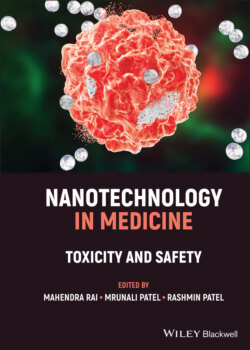Читать книгу Nanotechnology in Medicine - Группа авторов - Страница 2
На сайте Литреса книга снята с продажи.
Table of Contents
Оглавление1 Cover
2 Title Page
3 Copyright Page
4 Preface
5 List of Contributors
6 List of Abbreviations
7 Part I: Nanomedicine 1 Nanomedicines 1.1 Introduction 1.2 Nanomedicine's Revolution 1.3 Potential Applications of Nanomedicine 1.4 Clinical Translation of Nanomedicine 1.5 Nanotoxicological Challenges 1.6 Safety Issues and Regulations 1.7 Conclusion and Future Perspectives References 2 Microbial Biopolymers and Their Derivatives as Nanotechnological Tools for Medicine 2.1 Introduction 2.2 Natural Polymers: Conceptualization, Classifications, and Physicochemical Characteristics 2.3 Applications of Biopolymers in Nanoparticles, Nanofibers, and Drug Delivery Systems of Therapeutic Importance 2.4 Safety of Microbial Biopolymers Used in Nanoscale‐Systems for Therapeutic Applications 2.5 Conclusions References
8 Part II: Nanoparticles 3 Selenium Nanoparticles 3.1 Introduction 3.2 Selenium Forms 3.3 Toxicity of Selenium Nanoparticles 3.4 Toxicity Mechanisms 3.5 Conclusion References 4 Impact of Nanoparticles on Protozoa 4.1 Introduction 4.2 Nanosystems 4.3 Nanosystems with Effect on Human Parasitic Protozoa 4.4 Nanosystems with Effect on Veterinary Parasitic Protozoa 4.5 Nanomaterial Toxicity on Beneficial Protozoa 4.6 Conclusion Acknowledgment References 5 Toxicity of Metallic Nanoparticles 5.1 Introduction 5.2 Toxicity of Metal Nanoparticles and Influence of Physicochemical Properties 5.3 Accumulation and Toxicity of Metal‐Based Nanoparticles in Various Organs 5.4 Conclusion and Future Perspectives Acknowledgments References 6 Toxicity, Safety, and Biodistribution of Multifunctional Mesoporous Silica Nanoparticles 6.1 Introduction 6.2 Bioapplicability of Mesoporous Silica Nanoparticles 6.3 Biodistribution, Toxicity, and Safety of MSN 6.4 Safety Evaluation of Mesoporous Silica Nanoparticles 6.5 Conclusion and Future Directions References 7 Safety and Toxicity Issues of Polymeric Nanoparticles 7.1 Introduction 7.2 Application of Nanomaterials 7.3 Classification of Nanoparticles (NPs) 7.4 Nanotoxicology 7.5 Safety Assessment of Nanomedicines by Methodological Considerations 7.6 Conclusion and Future Perspectives References 8 Green Synthesis of Copper and Copper‐Based Nanoparticles for Their Use in Medicine 8.1 Introduction 8.2 Green Synthesis Methods of Copper and Copper‐Based Nanoparticles 8.3 Purification of Copper and Copper‐Based Nanoparticles 8.4 Characterization of Green Synthesized Copper and Copper‐Based Nanoparticles 8.5 Copper and Copper‐Based Nanoparticles as Nanomedicines 8.6 Copper and Copper‐Based Nanoparticles and Their Toxicity 8.7 Safety Implications of Copper and Copper‐Based Nanoparticles 8.8 Future Perspectives 8.9 Conclusion References
9 Part III: Nanotoxicology and Drug Delivery 9 Gene Delivery Using Nanocarriers 9.1 Introduction 9.2 Nanocarrier Types 9.3 Target Diseases and Routes of Administration 9.4 Learnings from Clinical Trials 9.5 Mechanisms of Toxicity of Gene Delivery Nanocarriers 9.6 Overcoming Toxicity Issues with Nanocarrier‐Mediated Gene Therapy 9.7 Future Perspectives and Conclusion References 10 Toxicity and Safety Evaluation of Lipid‐Based Nanoparticles for Brain Delivery 10.1 Introduction 10.2 Barriers Across Brain Delivery 10.3 Role of Lipid Nanoparticles in Brain Delivery 10.4 Transport Mechanisms Involved for Brain Delivery 10.5 Toxicity of Lipid Nanoparticles 10.6 Safety of Lipid Nanoparticles 10.7 Conclusion and Future Perspectives References 11 Risk Assessment of Injectable Nanoparticles Used as Nanomedicine 11.1 Introduction 11.2 Nanomaterials, Nanoparticles, and Nanoformulation 11.3 Injectable Nanoparticles Toxicity 11.4 Safety of Nanoparticles in Acute and Chronic Studies 11.5 Future Perspectives and Conclusion References 12 Dermatological Delivery of Nanodrugs 12.1 Introduction 12.2 An Overview of Dermatology and Nanodrugs 12.3 Nanomaterials for Dermatologically Active Nanodrugs 12.4 Nanoformulations for Topical and Transdermal Delivery 12.5 Applications of Dermatological Nanodrugs and Its Delivery Mechanisms 12.6 Toxicity Evaluation of Dermatologically Active Nanodrugs 12.7 Safety Considerations 12.8 Limitations and Risk 12.9 Conclusion References 13 Nanonutraceuticals 13.1 Introduction 13.2 Novel Carrier‐Based Drug Delivery Systems 13.3 Safety and Toxicity Assessment of Nanoparticles 13.4 Approaches for Biodegradable Nanoparticles 13.5 Modified Nanocarriers (Nanosponges) 13.6 Conclusion and Future Perspectives References 14 Current Challenges and Future Needs for Nanotoxicity and Nanosafety Assessment 14.1 Introduction 14.2 Nanomaterials: Risk Assessment 14.3 The Hurdles in Toxicity Evaluation of Nanomaterials 14.4 Nanosafety Assessment Tools 14.5 Conclusion and Perspectives References
10 Part IV: Nanotechnology, Ethics, and Regulatory Framework 15 Safety Regulations for the Use of Nanotechnological Products for Biomedical Applications 15.1 Introduction 15.2 The State‐of‐the‐art of Biomedical Applications of Nano‐Products 15.3 The Scientific Perspective on Nano‐products for Biomedical Applications, Risks, and Regulations 15.4 Using RRI as a Methodological Pathway Toward Communication Between the Science System and the Law System 15.5 Final Considerations and New Propositions References 16 Nanoethics and Nanotechnology 16.1 Introduction 16.2 Nanoethics 16.3 Conclusion References 17 Current Regulatory Framework in Nanotechnology and Medicine 17.1 Introduction 17.2 Quality Attributes and Regulatory Concerns of Nanomaterials 17.3 Quality Assessment of Nanomedicines 17.4 Current Regulatory Framework over Nanomaterials 17.5 Conclusion and Future Outlook References
11 Index
12 End User License Agreement
